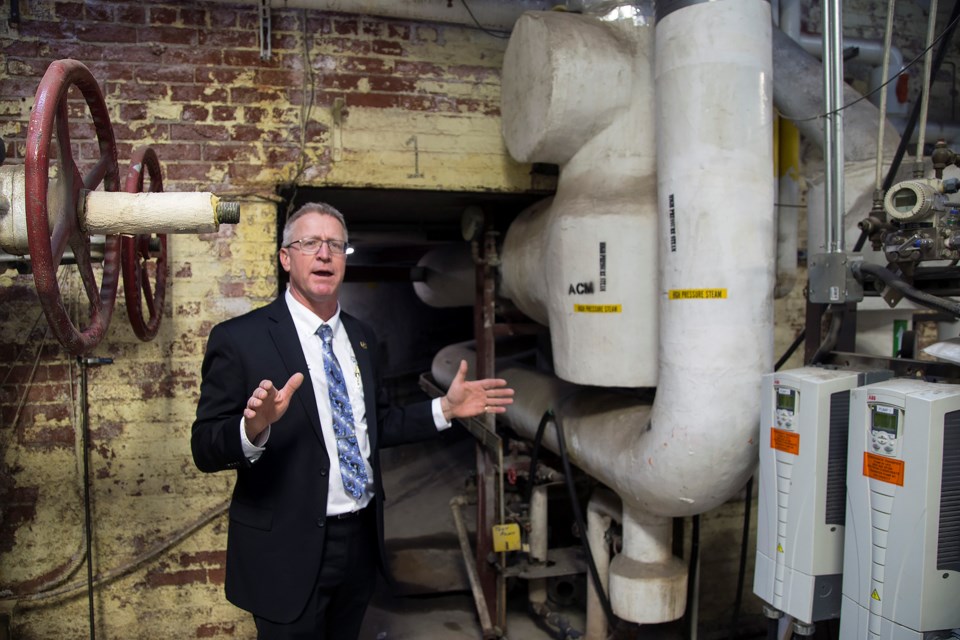A network of century-old underground steam tunnels that connects the buildings of the University of Guelph will be used to deliver a new green energy initiative and help the university meet its greenhouse gas emission goals.
The district energy tunnels were originally built to carry steam that was heated by centrally-located coal-burning boilers to heat the few buildings on campus at the time, said Steve Nyman, director of Maintenance and Energy Services at U of G.
As the university expanded, so did the series of tunnels and the coal-burning boilers were eventually converted to natural gas and the exhaust from those boilers is released by the large smokestack that stands at Central Utilities Plant directly behind Johnston Hall.
The tunnels are large enough to walk through and connect just about every building on campus.
It can be a task to keep students and other people out of the tunnel system, said Nyman.
“They are actually very dangerous, because you have 125-pounds of steam — which is 354 degrees Fahrenheit — on one side of the tunnel, with 13,700 volts on the other side,” he said. “Anyone could create a troubleshooting nightmare for us by closing some valves that we wouldn’t expect to have closed.”
Entering a restricted area on campus, like the steam tunnels, is considered a Level 3 offence — an action by an individual that can endanger their safety and security or of others and can result in eviction from residence or a suspension.
At least part of the original reason for the tunnel network, said Nyman, was to offer one centrally-located boiler, cutting down on the manpower needed to deliver and distribute the vast amounts of coal that would have been required to heat those first campus buildings at the turn of the 20th Century.
“By using district heating, they could concentrate all of that equipment in one spot and not have to equip each building with a furnace room and a coal chute and having people to stoke a fire at each building,” said Nyman.
As new buildings were built on campus, the tunnel network has expanded to its current size. In total, the underground network consists of about five kilometres of tunnels.
On Friday, the provincial government announced almost $26 million in funding for the university to improve energy efficiency on its campus.
The funding will be used, in part, to upgrade and expand its heat-recovery system — using the heat released by the stack at Central utilities to heat water that will be delivered in pipes to the buildings on campus through the district energy tunnels.
“We already do some stack heat recovery, but this is going to dramatically expand it,” said Nyman.
Capturing exhaust heat directly displaces the need to burn more natural gas, said Nyman, which can result in a reduction of greenhouse gas production.
The heated water will be used in academic, research and residence spaces, said Nyman, who said the initiative will account for a 3,200 tonne reduction in greenhouse gases.
The system is a closed loop, so any water that is not used returns to Central Utilities to be reheated and sent through the system again.
The original builders of the 1906 tunnel system couldn’t have known how much the university would expand, said Nyman.
With up to 30,000 people on campus at any given time, Nyman compares the university’s heating needs to a small city like Stratford.
“If we didn’t have a district energy system with underground tunnels, it would be next to impossible to extract that heat and then use it on campus, but because we have that network of underground tunnels, we can,” said Nyman.
The almost $26 million in funding will come from the provincial government’s Cap and Trade program, distributed through the Greenhouse Gas Campus Retrofit Program and will also include high-efficiency boiler replacements and the installation of energy-efficient windows.
The announcement was made Friday morning by Liz Sandals, MPP for Guelph.
One of the buildings that will benefit from the retrofit is the university’s MacNaughton Building, which was built in 1969 and named after Sandals’ father Earl MacNaughton.
She said the building was not built with energy efficiency in mind, which was typical of buildings of that era.
“Electricity and fuel was really cheap in the 60s, so it wasn’t a big criteria when you were building a building,” said Sandals.
Earlier this month, Sandals announced funding for new bike lanes and downtown bicycle parking as part of the Ontario Municipal Commuter Cycling Program, which is also funded by the province’s Cap and Trade program.
She said it's frustrating to hear that all four candidates vying for the Ontario PC Party leadership say they will scrap a tax on carbon emissions.
“There was so much scepticism about whether cap and trade would work. In fact, it’s worked really well,” said Sandals.
The university is already approaching its greenhouse gas emissions targets for 2030, said Nyman.
“Namely a 37 per cent reduction relative to our 1990 emissions — despite the campus growing in size by 40 per cent in that time,” he said.
